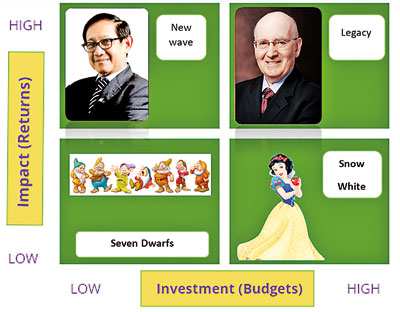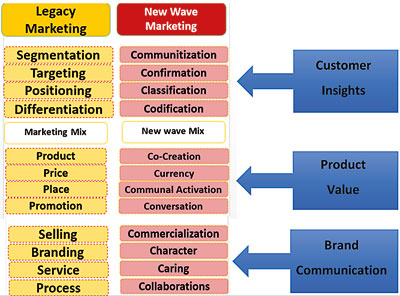Is Kotler Challenged again?
 In this ever changing world which is now further challenged by the global pandemic, marketers are challenged every single minute with changes taking place in the environment and also with the accelerated speed of change. Marketing is at times too dynamic to adapt and marketers are challenged all the time to come up with solutions for various issues that are surfaced by many aspects of the value creation process. The only constant tool they have is creativity which can deliver results if it’s used in a proper manner and creativity always needs to be adjusted to make business sense.
In this ever changing world which is now further challenged by the global pandemic, marketers are challenged every single minute with changes taking place in the environment and also with the accelerated speed of change. Marketing is at times too dynamic to adapt and marketers are challenged all the time to come up with solutions for various issues that are surfaced by many aspects of the value creation process. The only constant tool they have is creativity which can deliver results if it’s used in a proper manner and creativity always needs to be adjusted to make business sense.
On top of these challenges, creative ways to increase brand awareness, market share and sales are challenged today by the COVID19 pandemic which has brought up a new reality to our lives under the brand “New Normal”. It is thus crucial to keep up with new marketing concepts and strategies developed over time and this is where the New Wave Marketing comes in…
As per the Father of Modern Marketing Philip Kotlet: The nine principles of marketing which are also referred as “Legacy Marketing” are:
1. Segmentation, 2. Targeting, 3. Positioning, 4. Differentiation, 5. Marketing-Mix (Product, Price, Place, Promotion), 6. Selling, 7. Brand, 8. Service, 9.Process
In today’s context; business leaders are expected to have an understanding of complex situations, be agile in operations to face volatility, have thinking clarity in ambiguity and have a clear vision in uncertainty. However, they are easier said than done as there are many boundaries within which business leaders have to take decisions and implement them with limited resources.
In this backdrop, it’s worth inquiring the applicability of “Legacy Marketing” which was introduced by Kotler. As a matter of fact the fundamental thinking in marketing is challenged in today’s context as segmentation, targeting and positioning is not as easy as it used to be in the past where communication was mostly a one-way process, contrary to what is experienced today where consumers / “people” also can communicate about brands much louder than marketing communication does thanks to Social Media. Differentiation is challenged in an unprecedented way after the economic downturn in 2006/7 which is further challenged during the Covid19 pandemic as people are trying to satisfy basic needs with limited income. Marketing mix elements are also going through these changes and are facing challenges in many ways. The way products and services are offered, packed, and priced is having an impact from the current changes taking place in the environment. Most of the luxury brands have collapsed. As far as the services sector is concerned; airlines and hospitality sectors will not have much business in the foreseeable future. However, the real challenge is the ability to predict what is going to happen next year and the year after. Do we have enough information to predict what’s going to happen? Answer is a big NO… Do we know the outcome of our decisions? Answer is a big NO… The New Normal is still being defined and no one seems to know what could happen next. These challenges are going to make drastic changes in the way marketing plans are executed at ground level. In the meantime, safety measures need to be considered seriously in strategy implementation.

The New Wave of Marketing which was introduced to the world in 2016 by an Indonesian writer seems to have many implications in this context. What are the 12 elements of of New Wave of Marketing: Commoditisation, Confirming, Clarifying, Coding, Crowd-Combo (Co-Creation, Currency, Communal Activation, and Conversation), Commercialisation, Character, Caring and Collaboration.
Bellow typology is a comparison of the New Wave Marketing by Hermawan Kartajaya with Professor Kotler’s Legacy Marketing or Principles of Marketing; with New Wave Marketing.
New Wave Marketing principles, when applied, allows companies to reap huge benefits, “getting high impact with low costs” with sustainable competitive advantage over others that have not applied it.
High Impact – High Cost – Kartajaya has classified conventional marketing under this, which requires considerably money to be spent in advertising etc.
High Impact – Low Cost – the New Wave Marketing falls under this option which is about achieving the same impact at a lower cost.
The other two categories are not recommended by Kartajaya and he has named them after Seven Dwarfs and Snow White which comes in fairy tales.
Hence, it’s evident that the New Wave of Marketing focuses more on reaping better results with a lower investment. With reduced marketing budgets due to the impact of the pandemic, brands need to find creative and innovative solutions to reach out to their target audiences. Conventional wisdom of marketing is not going to be instrumental in certain categories and sectors. While Kotler speaks of more empathetic marketing campaigns in Marketing 4.0, there is a paradigm shift proposed by Kartajaya in his new approach in Marketing. As the next step, it’s worth taking an apple to apple comparison of each element in both Kotlet’s Legacy and Kartajaya’s New Wave.
 Kartajaya states that capitalism is better than communism; in other words the problem is not with capitalism it’s with people who are engaged in capitalism who are greedy and unethical. Kartajaya sees segments as communities. He further states that technology is making a paradigm shift in Marketing specially in communications; from one-to-many (One way communication) to many-to-many (two-way communication or multiple way) of which the latter is barely under control… where anyone can upload and anyone can download unlike in one sided communication takes place in traditional media. In one of his sessions he says: The world is still round and the markets are flat. He talks of authenticity of the source… He analyses the innovative approaches of Richard Branson of Virgin Atlantic to explain how Richard created a community called Virgin who would buy anything to do with Virgin; even Virgin Cola. Furthermore: he analyses Mark Zuckerberg’s creation of a platform (Facebook) where the users make content and the advertisers communicating in communities.
Kartajaya states that capitalism is better than communism; in other words the problem is not with capitalism it’s with people who are engaged in capitalism who are greedy and unethical. Kartajaya sees segments as communities. He further states that technology is making a paradigm shift in Marketing specially in communications; from one-to-many (One way communication) to many-to-many (two-way communication or multiple way) of which the latter is barely under control… where anyone can upload and anyone can download unlike in one sided communication takes place in traditional media. In one of his sessions he says: The world is still round and the markets are flat. He talks of authenticity of the source… He analyses the innovative approaches of Richard Branson of Virgin Atlantic to explain how Richard created a community called Virgin who would buy anything to do with Virgin; even Virgin Cola. Furthermore: he analyses Mark Zuckerberg’s creation of a platform (Facebook) where the users make content and the advertisers communicating in communities.
Segmenting to Commoditisation- In the New Wave Marketing; Segments have become communities in other words there are dozen different ways one can go about segmenting the market unlike how it used to be before. Communities are in the market and the consumers would decide what they exactly want in other words there is thin chance to persuade anyone through communication.
From Targeting to Confirmation- Instead of the marketers deciding on targeting, the targets will be confirmed by the segments, in other words, marketers need to get permission to enter the segments.
From Positioning to Clarification–Started back in late 1970s, positioning was all about a mind game and acquiring a mind share. But in the New Wave customers reject intended positioning of brands instead they clarify if the positioning is right or not.
From Differentiation to Codification – Differentiation is not authentic and it’s bolt-on. In today’s context, social media reveals the truth and the real thing of companies and brands. Hence, the brands need to be real and authentic and they need to codify their true identity. Customers will decide whether they acknowledge it or not.
 From Products to Co-creation– Unlike in traditional marketing, it’s not the company which designs the product or the offer. Customer would either decide on it or, will co-create with the brand. Instead of mass production, what’s happening now is mass customization.
From Products to Co-creation– Unlike in traditional marketing, it’s not the company which designs the product or the offer. Customer would either decide on it or, will co-create with the brand. Instead of mass production, what’s happening now is mass customization.
From Price to Currency – Price is something that the brands define vertically and send across to the market and it’s more of a one-way process. But in New wave; the price that the customer pays for the product will be decided by themselves. It’s more of a mutual process. No brand stands a chance to charge something that is not in the value that is offered to the customer.
From Place to Communal Activation– instead of brands developing channels to reach out to customers, the communities will invite brands to be a part of their activations. They will choose which brands they would associate with and how they consume.
From Promotion to Conversation – instead of one-way communication which takes place from brands to consumers, now the communication of brands go both ways in which consumers can send messages to the brand and most of the cases, the consumers co-create content of messages. It’s more of an ongoing dialogue between brands and people.
From Brands to Character – as the communication goes both ways and as content is co-created, unlike when the communication was working on one-way, not brands need to have clean records. Brands character matters more than performance today. If a brand uses harmful ingredients or raw material in the process, no matter how good the performance is, the brands will not be considered as a great brand.
From Sales to Commercialisation – in Legacy marketing the emphasis was on closing sales, and making a sale. In New wave, the focus is on creating value and sharing the benefits where customer knows how much he/she is charged and for what elements. There can be no hidden cost elements in the price.
From Service to Care – in services marketing, customer was the king and brands were slaves. There was no room for mistakes. Everything had to be perfect and it’s more like red carpet treatment. But today, it has changed and customers value real things, authentic experience and memorable experiences than service deliveries. Customers engage in providing the service today. Hence all what they want is care. Customers also expect brands to be more empathetic as brands too can have more information about customers than they used to have before.
From process to Collaboration– under Legacy marketing, as per Kotler, the customer has to go through a process in obtaining services for example. But under New wave, there is a collaboration between the customer and the brand or the marketer in co-creating most of the elements of the marketing mix. DIYs, choosing your own menu items in many different ways, customers engage in the process and in the same way, suppliers, intermediaries, etc are also involved in the process.
In conclusion, it’s evident that the New Wave Marketing has emerged as a result of information availability and virtual markets and services which have become possible thank to internet. With the availability of information, people want to know the truth. Seeking for truth or real thing drives consumers for authentic experiences and authentic products. By and large these two have contributed towards the increasing applicability of The New Wave Marketing.
However, it should be noteworthy that the extant of Marketing which comprises of many seminal work of scholars starting all the way from Al Ries in 1970s to, Micheal Porter in 1980s, Aaker and Keller and kapfererin 1990s, and then to Kotler in 2000; many scholars have contributed to the development of Marketing to be where it is today as a discipline. The fundamentals will always be relevant and be applicable under any context as base concepts. Nevertheless there will also be new concepts which would arise to cater the needs of changing contexts in today’s VUCA environment.


